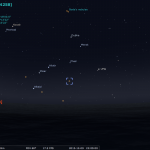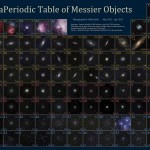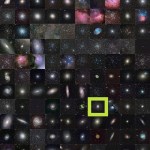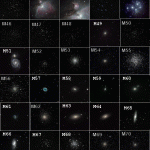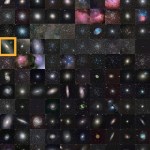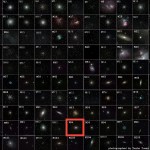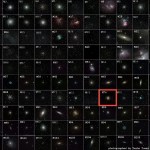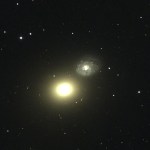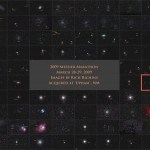galaxy
The ‘Nifty Fifty (times 4)’, a program of Science Spark, presented by InfoComm International, are a group of 200 noted science and engineering professionals who will fan out across the Washington, D.C. area in the 2014-2015 school year to speak about their work and careers at various middle and high schools.
Meet Nifty Fifty Speaker Dr. Loren Anderson
Loren Anderson, a noted physicist at West Virginia University, works in an elite and highly specialized area of astrophysics. His research focuses on Galactic HII regions in our galaxy. HII regions are ionized zones around young and very…
"Tomorrow is the most important thing in life. Comes into us at midnight very clean. It's perfect when it arrives and it puts itself in our hands. It hopes we've learned something from yesterday." -John Wayne
There's a lot to look forward to on the precipice of the new year, and many of us will be up until midnight to ring it in. Well, if you're up that late, why not step outside and take a look at one of the deep-sky wonders of the Universe that won't be visible in the early part of the night for months! This Messier Monday, a near-moonless sky will greet you until the pre-dawn twilight, and…
"Where you used to be, there is a hole in the world, which I find myself constantly walking around in the daytime, and falling in at night. I miss you like hell." -Edna St. Vincent Millay
It was just a little while ago that we were all speculating wildly -- and optimistically -- about Comet ISON, as it plunged towards the Sun from its origins in the very, very distant Solar System. As its perihelion date (the moment of closest approach to the Sun) drew near, you may have noticed something interesting about photos of the comet: it's tail appeared to get longer and longer!
Image credit &…
"The proverb warns that 'You should not bite the hand that feeds you.' But maybe you should, if it prevents you from feeding yourself." -Thomas Szasz
But on this Messier Monday, you're lucky enough that you're about to be introduced to one of the great northern galaxies of the Messier catalogue that is feeding itself! There are 110 deep-sky, non-transient objects that make up the Messier catalogue, and a full 40 of them are galaxies, the most numerous and most distant of all the types of objects catalogued by Messier.
Image credit: Tenho Tuomi of http://www.lex.sk.ca/astro/messier/…
"I should like to lie at your feet and die in your arms." -Voltaire
Every object that we look at for Messier Monday has its own flavor, its own qualities, and its own unique characteristics. By far the most numerous of the 110 deep-sky objects making up the Messier catalogue are the galaxies, of which there are 40. It's best to observe them on moonless nights, as their surface brightness is spread out across a large area, and even a crescent Moon's presence in the night sky can make all but the brightest of these galaxies invisible to the eye, even in good equipment.
Image…
"The battle, sir, is not to the strong alone; it is to the vigilant, the active, the brave." -Patrick Henry
It's not a good idea to showcase a galaxy for you every Messier Monday, considering that even a crescent Moon can render most of them completely unobservable. Now that the autumnal equinox has passed, however, a very special spiral will be visible after sunset for the next six months or so in a relatively nondescript part of the night sky. Out of the 110 deep-sky objects that comprise the Messier catalogue, a full forty of them are galaxies, although today's object wasn't…
"It is by going down into the abyss that we recover the treasures of life. Where you stumble, there lies your treasure." -Joseph Campbell
It took Charles Messier and his assistant, Pierre Méchain, a lifetime to scan and survey the sky for all the permanent deep-sky objects visible in their telescopes that could possibly be confused for comets on first class. More than 200 years later, these 110 deep-sky objects are among the best seen and most wondrous sights of the Universe, accessible to anyone with a decent telescope and dark skies. This Messier Monday, let's look the farthest into the…
"Like all animals, human beings have always taken what they want from nature. But we are the rogue species. We are unique in our ability to use resources on a scale and at a speed that our fellow species can't." -Edward Burtynsky
It's really a romantic notion when you think about it: the heavens, the Milky Way, is lined with hundreds of billions of stars, each with their own unique and varied solar systems.
Image credit: 湖北直行便 of AstroArts, via http://www.astroarts.jp/photo-gallery/photo/13870.html.
But beyond that -- in addition to the stars -- there are hundreds of billions of planets…
"One sees qualities at a distance and defects at close range." -Victor Hugo
A couple of weeks ago we took a look at the most distant galaxy (so far) in the known Universe, a galaxy so far away that it takes exclusively infrared observations from our most power space telescopes (Hubble and Spitzer) in order to detect it. What's perhaps even more remarkable is that the light we do detect from it -- the light we detected in the infrared -- was actually emitted in the Ultraviolet part of the spectrum!
Image credit: NASA, ESA, Garth Illingworth (University of California, Santa Cruz) and…
"We find them smaller and fainter, in constantly increasing numbers, and we know that we are reaching into space, farther and farther, until, with the faintest nebulae that can be detected with the greatest telescopes, we arrive at the frontier of the known universe." -Edwin Powell Hubble
With 110 deep-sky objects scattered throughout the heavens, the Messier Catalogue provides skywatchers across the globe with a number of spectacular targets, from nearby nebulae and clusters to spectacular, distant galaxies. Each Monday, we spotlight a new one right here.
Image credit: Rolando Ligustri,…
"I am undecided whether or not the Milky Way is but one of countless others all of which form an entire system. Perhaps the light from these infinitely distant galaxies is so faint that we cannot see them." -Johann Lambert
When we look out at the Universe, our view is pretty consistently dominated by the stars within our own galaxy. Although we know that many interesting things lie beyond -- globular clusters, individual galaxies, and rich clusters and superclusters of galaxies -- being in the Milky Way makes it very hard to see beyond it.
Image credit: Richard Payne, of Arizona…
"We dance round in a ring and suppose, but the secret sits in the middle and knows." -Robert Frost
It's time again for another Messier Monday! To kick off each week, we've been taking a look at one of the 110 deep-sky objects that make up the Messier catalogue. Compiled in the 18th Century to help skywatchers avoid these fixed night sky wonders (so that they could better hunt comets), these represent some of the most viewed and easily visible nebulae, star clusters and galaxies visible from our home world.
Image credit: Tenho Tuomi of Tuomi Observatory, via http://rockpoint.dyndns.org…
"Most writers spend their lives standing a little apart from the crowd, watching and listening and hoping to catch that tiny hint of despair, that sliver of malice, that makes them think, 'Aha, here is the story.'" -Ayelet Waldman
Welcome back again to another Messier Monday, where we're all set to take an in-depth look at one of the 110 deep-sky wonders that make up the Messier catalogue. Looking at the nearby stellar remnants, star-forming regions and young star clusters, as well as the more distant and larger globular clusters, the most common of all the Messier objects are also…
"It's coming right for us!" -Uncle Jimbo, from South Park
Welcome back to another Messier Monday, only here on Starts With A Bang! Each Monday, we take an in-depth look at one of the 110 deep-sky objects that make up the Messier Catalogue, the first accurate and comprehensive deep-sky catalogue of relatively bright, extended celestial objects that can be viewed with even the most primitive of skywatching equipment under good skies. Each one of these objects -- ranging from nebulae to star clusters to galaxies -- holds its own, unique story.
Image credit: © 2008 by Patrick Freeman…
"Upon one occasion, while engaged upon a seven-foot mirror, he did not remove his hands from it for 16 hours together." -from Caroline Herschel's obituary
Welcome to another Messier Monday here on Starts With A Bang! Each Monday, we highlight a different one of the 110 deep-sky objects that Messier catalogued so that comet-hunters wouldn't confuse these permanent fixtures with transient comets. But each object has a unique, remarkable story in its own right.
Image credit: The Messier Objects by Alistair Symon, from 2005-2009.
Out of the 110 objects, a full forty of them are…
"When you run the marathon, you run against the distance, not against the other runners and not against the time." -Haile Gebrselassie
Welcome to a very special Messier Monday, which just happens to be the twenty-first consecutive week we've taken a look at one of the 110 fixed, deep-sky objects that Messier and his collaborators catalogued to avoid confusion with comets.
Image credit: Tenho Tuomi, of his completed Messier Marathon.
Today's Messier Monday is very special, because today is the new Moon closest to the vernal equinox. Each year, on (or very close to) the vernal equinox --…
"Let the great world spin for ever down the ringing grooves of change." -Alfred Lord Tennyson
Welcome back, for another Messier Monday here on Starts With A Bang! Each Monday, we've been taking a look at one of the 110 Deep-Sky Objects that make up the Messier catalogue, a mix of clusters, nebulae, galaxies and more, all visible from most locations on Earth with even the most basic of astronomical equipment.
Image credit: Greg Scheckler, from his 2008 Messier marathon, where he nabbed 105/110.
When you think of our local group of galaxies, you probably think of the Milky Way and Andromeda…
"The thing's hollow—it goes on forever—and—oh my God—it's full of stars!" -Dave Bowman, 2001: A Space Odyssey
Back in October, we began a new, weekly series here called Messier Monday. Each Monday, we've taken a look at one of the 110 deep-sky objects that make up the Messier Catalogue, nebulous objects that might potentially be confused with comets by unaware comet-hunters.
Image credit: Lee Kelvin and Grant Miller, via http://star-www.st-and.ac.uk/~lsk9/.
These objects include stellar remnants, star-forming nebulae, young star clusters, ancient globular clusters, and distant galaxies far…
"Modern man must descend the spiral of his own absurdity to the lowest point; only then can he look beyond it." -Vaclav Havel
But the spiral is more than a metaphor or a mathematical shape, it's also the most common feature observed in the galaxies out there in the Universe. There are 27 spiral galaxies in the Messier Catalogue, and today I want to show you how to find the most southerly of them all!
Image credit: Rich Richins, of all 110 Messier objects (in no particular order). M83 boxed.
The Southern Pinwheel Galaxy, also known as Messier 83, is a full 30 degrees south of the celestial…
“Men... have had the vanity to pretend that the world creation was made for them, whilst in reality the whole creation does not suspect their existence.” -Camille Flammarion
Welcome to the latest -- and most controversial -- Messier Monday, where each week, I'll take a look at one of the 110 deep-sky objects that make up the Messier catalogue. These objects were identified so as not to be confused with potential comets, and make up the brightest and best-known observational sights beyond our own Solar System. But there is one object that, if you go to the wikipedia list, that has not…



